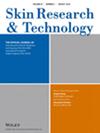原花青素通过调节 TLR4/MyD88/NF-κB通路减轻炎症和氧化应激,从而减轻白癜风的病情
IF 2
4区 医学
Q3 DERMATOLOGY
引用次数: 0
摘要
目的研究原花青素(PCs)治疗类白癜风(HSP)大鼠模型的疗效和机制,重点是炎症和氧化应激(OS)反应。方法使用卵清蛋白(OVA)注射建立类白癜风大鼠模型,导致模拟 HSP 的症状。研究测量了炎症标志物(IL-4、IL-17、TNF-α)、OS 标志物(MDA、SOD、CAT),并通过组织病理学和免疫荧光分析评估了 TLR4/MyD88/NF-κB 信号通路的参与情况。血清分析显示,多糖可有效降低 IL-4、IL-17、TNF-α 和 MDA 水平,同时提高 SOD 和 CAT 水平(p < 0.05)。结论 PCs 主要通过抑制 TLR4/MyD88/NF-κB通路,减轻炎症反应和氧化损伤,对 HSP 类大鼠显示出良好的治疗效果。这些发现表明 PCs 是治疗 HSP 的潜在途径,值得进一步研究。本文章由计算机程序翻译,如有差异,请以英文原文为准。
Proanthocyanidins alleviate Henoch‐Schönlein purpura by mitigating inflammation and oxidative stress through regulation of the TLR4/MyD88/NF‐κB pathway
ObjectiveInvestigate Proanthocyanidins (PCs) efficacy and mechanisms in treating Henoch‐Schönlein purpura (HSP)‐like rat models, focusing on inflammatory and oxidative stress (OS) responses.MethodsAn HSP‐like rat model was established using ovalbumin (OVA) injection, leading to symptoms mimicking HSP. The study measured inflammatory markers (IL‐4, IL‐17, TNF‐α), OS markers (MDA, SOD, CAT), and assessed the TLR4/MyD88/NF‐κB signaling pathway's involvement via histopathological and immunofluorescence analyses.ResultsPCs treatment significantly improved HSP‐like symptoms, reduced inflammatory cell infiltration, and decreased IgA deposition in renal mesangial areas. Serum analyses revealed that PCs effectively lowered IL‐4, IL‐17, TNF‐α, and MDA levels while increasing SOD and CAT levels (p < 0.05). Crucially, PCs also downregulated TLR4, MyD88, and NF‐κB expressions, highlighting the blockage of the TLR4‐mediated signaling pathway as a key mechanism.ConclusionPCs show promising therapeutic effects in HSP‐like rats by mitigating inflammatory responses and oxidative damage, primarily through inhibiting the TLR4/MyD88/NF‐κB pathway. These findings suggest PCs as a potential treatment avenue for HSP, warranting further investigation.
求助全文
通过发布文献求助,成功后即可免费获取论文全文。
去求助
来源期刊

Skin Research and Technology
医学-皮肤病学
CiteScore
3.30
自引率
9.10%
发文量
95
审稿时长
6-12 weeks
期刊介绍:
Skin Research and Technology is a clinically-oriented journal on biophysical methods and imaging techniques and how they are used in dermatology, cosmetology and plastic surgery for noninvasive quantification of skin structure and functions. Papers are invited on the development and validation of methods and their application in the characterization of diseased, abnormal and normal skin.
Topics include blood flow, colorimetry, thermography, evaporimetry, epidermal humidity, desquamation, profilometry, skin mechanics, epiluminiscence microscopy, high-frequency ultrasonography, confocal microscopy, digital imaging, image analysis and computerized evaluation and magnetic resonance. Noninvasive biochemical methods (such as lipids, keratin and tissue water) and the instrumental evaluation of cytological and histological samples are also covered.
The journal has a wide scope and aims to link scientists, clinical researchers and technicians through original articles, communications, editorials and commentaries, letters, reviews, announcements and news. Contributions should be clear, experimentally sound and novel.
 求助内容:
求助内容: 应助结果提醒方式:
应助结果提醒方式:


